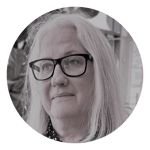The unit for health development within Region Stockholm is responsible for the operational grants that non-profit organizations can apply for each year. Big and small organizations are awarded these grants to support their work toward promoting good and equal health.
Every year, administrators within the Health Development Unit receive grant applications from more than 80 organizations. These applications are manually processed, compiled, and presented to politicians for decision-making. The granted funds are then distributed.
They used several paper-heavy processes to manage all these applications, relying on printed PDF files and Excel documents throughout. In 2020, they sought help from Flowfactory to build a digital case management system, and today they have much faster and simpler processes for both administrators and grant-seeking organizations.
Time-consuming processes with paper and Excel sheets
Lis-Marie Kanon, an administrator at the unit for knowledge development at Region Stockholm, was involved in the entire system transition journey with Flowfactory. She recalls the time before the new system was implemented as painful.
"The whole process took a very long time: first, the time involved in handling a large number of documents, and then having to enter the details from each document into a separate Excel document. It also required a large number of administrators to get involved in order to see the application through to a decision," Lis-Marie recalls.
“
“I didn't know anything about low-code before, but it turned out I didn’t need to!”
- Lis-Marie Kanon, Programme Officer Region Stockholm

In the end, the head of the unit realized the situation was unsustainable. After trying to find a solution internally, they finally got help from Ruth Laporte, digital change manager at Region Stockholm. She helped find external options that would solve their challenges.
"The burden and workload the administrators had before the digitization of operational grants was huge, and the situation was no longer acceptable from a positive working environment perspective," says Ruth.
An important step toward digitization
Region Stockholm set its sights on a digitized future a few years ago, but despite this, it wasn't entirely easy to get all employees on board the digital transformation journey. The healthcare administration was early in adopting digital solutions compared to other departments within Region Stockholm. Eventually, they decided to try Flowfactory, which turned out to be a good match.
"There were several of us who weren't so familiar with the digital world, and who would have preferred to continue as we always had," Lis-Marie admits. "I also didn't know anything about low-code, but then again, I didn't need to! Flowfactory taught us everything we needed to know, and today, there aren't many skeptics left."
A close collaboration led to the system being used after just 8 weeks
When the collaboration began, Lis-Marie and her colleagues knew what they wanted from the system, which made it much easier to build.
"We had the foundation; we knew we wanted to convert the paper process for applications into a digital system. But we made several changes along the way and got great suggestions from Flowfactory's low-code developers, who challenged our ways of thinking. The give and take was perfect as we worked together on the solution. Most aspects of the system were ready and could be used after just 8 weeks."
Once they got the system up and running fully, a successful collaboration could begin.
"We really felt that Flowfactory was responsive to us and our needs as administrators, which felt reassuring. Slowly but surely, the system evolved. Now that all applications could come into the same system, everything could be read digitally, and we could handle data more easily. It felt absolutely amazing!"
Low-code technology opens up the potential for increased creativity
Since low-code is a system development approach based on drag-and-drop technology with a visual interface, it opens up the possibility for direct collaboration between developers and administrators — without intermediaries. Lis-Marie and a colleague worked side by side with Flowfactory's low-code developers and created the solution together, which led to increased creativity and mutual understanding.
"It was actually very fun. We felt involved and part of the solution instead of having a solution presented to us three months later. This way, we could influence the outcome at an early stage instead of giving feedback afterward. Then we felt proud afterward to have been part of creating the system!"
The introduction of the new system had several positive effects. Administrators could take on other tasks, as the new system freed up time. Work dynamics improved; more satisfied employees led to more satisfied grant applicants. The employees felt proud to have been able to contribute their knowledge to the design of the case management system.
Finally, Ruth Laporte discusses what she looks for when choosing suppliers for critical projects like this one.
"In my experience, it’s important not only to look at cost savings, but also what you get and what the goal of the solution is. Who is responsible – who ultimately will do the work? What is the relationship between supplier and customer, and is there a willingness from the supplier to understand one's needs and contribute a real benefit to society? That's what I prioritized and found in Flowfactory!"

About Region Stockholm
Region Stockholm is responsible for ensuring that the county's residents receive the healthcare and dental care they need. The health care administration within Region Stockholm covers everything from healthcare and health promotion to research, education and development. The Health Development Unit is responsible for issues promoting equality in improved health and reducing health inequalities in the region.
